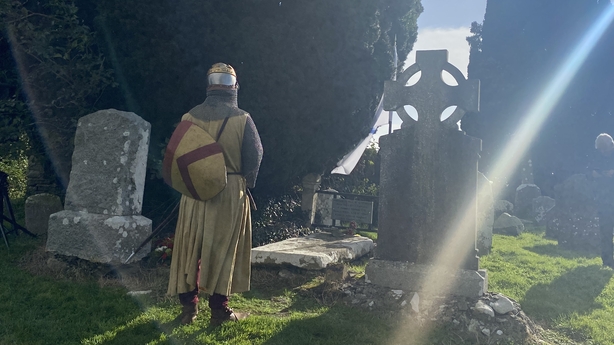A commemorative stone for Edward Bruce, the so-called "last High King of Ireland", has been officially unveiled in Co Louth.
The "Bruce boulder" is located at the Old Faughart Graveyard, north of Dundalk.
It was at the Hill of Faughart that Edward Bruce was killed in battle 705 years ago, today.
Some of his remains are believed to be buried in the Old Graveyard there.
His direct descendant Charles Bruce travelled from Scotland for a special ceremony to unveil the stone.
It is one of a number commissioned by The Ulster-Scots Agency to mark important sites linked with Edward Bruce.
Edward Bruce was a brother of the King of Scots, Robert the Bruce, and led a three-year campaign in Ireland, starting with the invasion in 1315.
After seizing the town of Carrickfergus in Antrim, he is said to have been proclaimed the King of Ireland, and later crowned King in Dundalk.
The complex campaign ended after Edward Bruce was killed at the Battle of Faughart on 14 October 1318.
It was here his depleted army was defeated by Anglo Norman forces.
His head was sent to King Edward II, and at least some of his remains are believed to be buried in the Old Graveyard in Faughart.
A flat stone lies over the plot in the hilltop graveyard, surrounded by magnificent views of Dundalk Bay.

The stone forms part of the "Bruce Trail" and so far, this is the only one located south of the border or outside Ulster.
The trail is an initiative of the Ulster-Scots Agency, which set up as part of the Good Friday Agreement and is responsible for protecting, developing and promoting the language, heritage and culture of Ulster-Scots people.
Although Edward Bruce pre-dates the "Ulster-Scots" who came to Ireland from 1606, Ian Crozier, Chief Executive of the Ulster-Scots Agency says that his story is of significance to them.
"They are stories of migration from Scotland to Ulster," he said.
"The short distance between Scotland and Ulster is a distance people have been travelling for thousands of years, and we are the latest example of that.
"So the same people who came with the Ulster-Scots from 1606 onwards, are probably some of the people whose families were there with Edward Bruce in 1315."
Mr Crozier said it was important for people understand the complex, shared history involved.
"There are a lot more nuances to history in Ireland than we often think. It's very easy to go for Wikipedia, myths, stories and ideas handed down through generations, which doesn't necessarily reflect history.
"It is important for us to understand what actually happened and the complex relationships that have existed between different peoples throughout these islands for 2,000 years or more."
A son of the Earl of Elgin and 37th Chief of the Bruce, Charles Bruce said he was representing his father who is about to turn 100 years old in February.
"I'm a lineal descendant of Edward Bruce, who died here at the Battle of Faughart. He was the only surviving brother of King Robert. It was a moment when the family almost disappeared without trace. So we kept going.
"We held the crown of Scotland for two generations and very briefly held this extraordinary position of High King of Ireland from 1315 to 1318," he said.

Mr Bruce said that there was a kinship connection between Scotland and Ireland.
"It is wonderful to be a part of living history, but it means different things to different people, so it's very inclusive."
Local historian Dr Alison Lennon says that the Bruce campaign is a very early example of the shared history between Ulster and Scotland.
She explained that Edward Bruce was sent here by his brother Robert, who was the King of Scotland and was fighting the Scottish War of Independence against England in the early 14th century.
She said the purpose of the campaign was to "open a second front against the English, by attacking the Anglo Normans" and that a lot of Gaelic leaders would have aligned with him initially.
Before his defeat and death at Faughart, Edward Bruce was crowned King of Ireland.
"He was the last time that we had one King, supposedly reigning over the whole of Ireland.
"It wasn't actually quite that simple, it was a very complex war and the campaign here in Ireland was very complex. But we do know he was crowned High King of Ireland here in Dundalk," she said.
Today's event was hosted by the Faughart Community Group, who want to raise awareness of the significance of the site, not just in relation to Edward Bruce.
Alan McArdle said that Faughart is "oozing with history", as the final resting place of the last High King of Ireland, but also its ancient history going back to the folklore of Cúchullain and Queen Maeve, and the facts around the birthplace of St Brigid.
It also boasts a holy well, a medieval abbey, a monastic site, and an Anglo-Norman motte.






